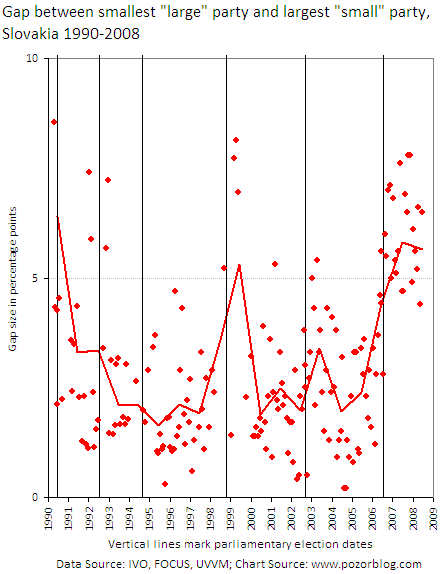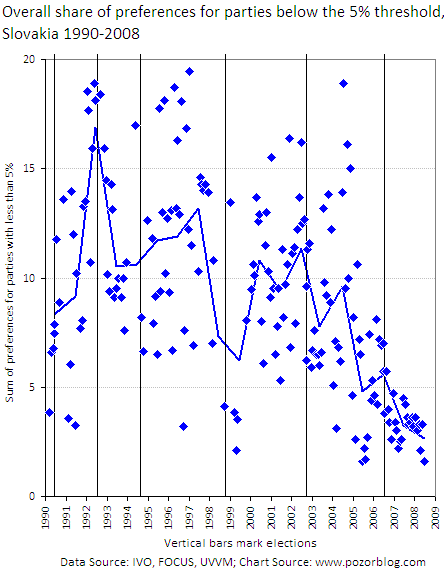Smer at half-time
UVVM caused a minor stir with this month’s poll which shows Smer support at near-record levels (46.7%, a level higher than any but that of early 2007’s 47.7%). The dominance of the party is remarkable. Meciar’s HZDS on only one occasion–the election of September 1994 and the first poll immediately following–received preferences that were more than three times greater than its nearest opponent. The Smer’s current polling support is 3.5 times that of SDKU, and the average ratio between Smer and next largest party support over the past two years is 3.2.

While there is no questioning the party’s remarkable position, it is necessary to take at least one step back. Pravda‘s headline, for example, reported that “Smer approaches 50% @@@ but there is no evidence whether the current level is a more of a trend or a peak. Since 2007 each peak above 45% has been followed by a drop back near the 40% level, with no clear trend of overall rise or fall in the level of peaks and valleys. Nor is it clear that 45% support in the polls means 45% in elections, as some Smer activists have taken pains to point out to me. This is itself unusual, since party supporters–even those of HZDS at its peak in the mid-1990’s have often argued that polls under-estimated their party’s support. In this case, Smer’s very success has forced a certain amount of caution lest even an unprecedented electoral showing by the party be regarded as a “loss” because it failed to match the polls. The caution seems warranted in light of other surveys.
Averages of the “big three” surveys over the past two years smooth out the hypothesized levels of Smer support. On the one hand, these show a lower level of overall support: closer to 42% than 46%. On the other hand, unlike the UVVM figures, these actually show a steady, if moderate growth in Smer support over the last six months, and the current level of 42.6% for June 2008 is Smer’s highest ever “average” score for months which produced two or more surveys.

Of course it is important to be wary of the “average” figure when looking for short-term trends since this figure depends on which polling firms report in a given month, and as regards Smer, polling firms find quite different results. The following table shows results for the “big three”: whereas in April 2008 these were nearly identical, in June 2008 the difference between UVVM (which has consistently produced the highest results for Smer, about 3 percentage points above the average) and MVK (usually somewhere in the middle, about 1% below the average) was huge: 8.2 percentage points. Put in perspective, this “Gap” in Smer results is larger than the entire electoral support of HZDS or KDH.

Which of these polling firms is closest to the actual number, none can say. UVVM final poll results in both 2002 and 2006 were slightly less inaccurate than those of MVK or FOCUS%20%28t%29% (according to one mode of calculation, 17% versus 24% and 28% in 2002; 23% versus 28% and 33% in 2006), but final results for Smer were nearly identical among the big three. There is a chance that MVK records somewhat lower levels for Smer because the firm is the only one that explicitly includes on its list of choices Slovakia’s small Green Party (ZS) which might draw support away from Smer (with which ZS has signed a strategic cooperation agreement).
It is diffcult, however to translate these polling numbers into actual electoral results. In 2006 the final polls were not too far off, differing from the actual result by an average of 2 percentage points, but election campaigns make a difference and there was considerable motion in these polls in the month before elections.
Toward this end it may be relevant to point out that while Smer’s relative position compared to other parties has remained high and stable, its absolute position compared to the electorate as a whole has actually weakened somewhat since early 2007 because of a slowly rising share of voters who either have no preference or do not intend to vote. According to UVVM, this share has risen from 22.9% shortly after the election to 36.5% in the most recent survey. (UVVM changed its methodology for asking this question in mid-2007 but this does not appear to have changed the overall level by any significant margin). As a result, Smer’s share of the overall electorate has dropped from around 32% in the first half of 2007 to around 29% in the first half of 2008. Since other parties shares have of course dropped by similar percentages, this does not reflect a particular weakness in Smer, but the increasing level of indifference and fatigue opens the possibility of new dangers and new opportunities.
Other parties at half-time
As with Smer, the overall positions of other parties are relatively unchanged, not only from the previous month but from two years ago. The most recent data confirms the disappearance of the “two-tier” pattern separating SDKU and SNS from HZDS, MK and KDH but otherwise shows little major change.

Nor do these patterns differ from those of the immediate post-election period in 2006. Indeed, as the chart below shows the relative positions of the parties averaged for all polls for the first half of 2008 months are almost exactly the same as those of the last half of 2006. Nor are the absolute positions much different: SDKU varied slightly over time but ended up where it started (moving from 14.0% to 13.8%), SNS rose steadily but slightly (from 12.0% to 12.9%), SMK dropped steadily and slightly more (from 10.6% to 9.2%) as did HZDS (from 9.6% to 8.3%). Of the parliamentary parties other than Smer, only KDH showed any rise and even that was quite small (7.8% to 8.4%). Among the non-parliamentary parties there was also little change. KSS remained almost unchanged (falling slightly from 2.5% to 2.2%), as did HZD (shifting from 1.3% to 1.0%) and ANO (from 1.0% to 0.7%. Only SF dropped significantly (from 2.6% to 1.1%)

It is worth considering briefly the differences among polling firms on these parties. As with Smer, UVVM numbers for SDKU exceed the average on a consistent basis whereas FOCUS and MVK often show lower numbers. The difference between polls is smaller than that of Smer in absolute terms (around 1%-3% for SDKU compared to around 3%-9% for Smer) but this almost identical relative to the size of overall party preferences

For SNS differences are even smaller with no clear tendencies by any particular firm to poll consistently higher or lower than the average.

For the Hungarian Coalition (MK), the most recent 3 months show higher survey numbers from UVVM than from other survey firms, but this follows on several months in which UVVM numbers were systematically lower. Because MK support should be more stable than that of other parties (given it’s close correlation to ethnicity), such shifts call attention to a potential change in survey networks, and suggest, by extension, that other parties may be similarly affected by hidden shifts in methodology or even in the composition of the survey network. Such shifts may actually have a greater effect than changes in actual preference.

As with SNS, HZDS shows relatively small differences among survey firms. The UVVM figure of more than 10% for April 2008 appears by this standard and by the standard of other polls before and after to be artificially high.

As with SDKU and Smer, KDH scores differer significantly according to the polling firm, with differences higher, on a relative basis, than for any other party (over 30% of the party’s average score). Here, however, it is FOCUS scores that are higher and UVVM scores that are lower. The overall averages, however, are remarkably stable.

Among the non-parliamentary parties, the numbers are now so low as to prevent close analysis but it is worth noting that UVVM consistently produces lower scores for KSS than do other polls (UVVM’s numbers average around 1%; for FOCUS and MVK the average is around 3%-4%).

For the other smaller parties, however, there is a far smaller difference, and indeed there is no room for difference since these parties regularly poll around 1%. Below you can find SF as an example, but HZD and ANO are not terribly different.

Government and opposition at half-time
The movements of various parties tend to cancel one another out such that by various reckonings, there has been little change in Slovakia’s overall political balance since late-2006. UVVM polling, in particular, shows an almost flat trendline from October 2006.

As above, average polling shows a slightly lower level for the current coalition but also a slight positive trend.

The composition of some of the tradeoffs is visible in the otherwise somewhat problematic assigning of parties to ‘blocs’. This shows, however, that the recent gains of Smer have been offset by losses among the “Slovak National” parties HZDS and SNS. The “Hungarian National” bloc and the “Right,” consisting of SDKU and KDH, remained stable (despite those parties’ internal struggles).

Dividing the same data in a different way–according to the number of the parliamentary seats that a party might win–shows this tradeoff in an even clearer fashion. The key area of change here is the relative size of Smer’s orange compared to the combined brown of HZDS and dark green of SNS.

Of course it is important not to ignore the absolute levels either, and Smer’s dominance here is so significant that the party would remain well positioned even in the case of significant changes (which there have not been). Indeed, UVVM data shows Smer remarkably close to a one parliamentary majority (Meciar’s HZDS, at its popular height in 1992 obtained 74 seats, but much of that came on the basis of redistribution from the large number of parties fell just short of the parliamentary threshold.

Even average preferences show Smer just 7 seats short of a parliamentary majority. Since the parliamentary threshold means that even the smallest party in Slovakia’s parliament, must have at least 7 seats, current polling numbers would amost guarantee a 2-party government dominated by Smer…

Of course current polling numbers are only obliquely related to electoral results, especially those 2 years away. In a future post I hope to be able to take a look at half-time in previous electoral cycles.


